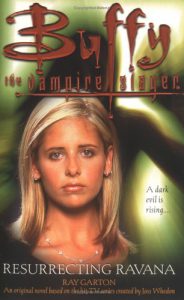This might sound like an odd statement, but Ray Garton writes a pretty darn good “Buffy” novel despite having a tenuous grasp of the show. “Resurrecting Ravana” (2000), about an ancient Hindu demon that descends on Sunnydale (drawn by the Hellmouth, natch), is a good mystery yarn, and he makes sharp observations about the nature of magic.
There are numerous instances that make me wonder about his familiarity with the TV series, though. At one point, Garton (writing his only book in the series) makes mention of multiple tables in the library, when we all know there is one big table in the middle. For example, on page 39: “Xander and Oz returned to their table and Cordelia returned to hers.” At another point, several students enter the library and the gang lowers their voices; Garton plays it as if it’s normal for students to come into the library. The show, by contrast, at one point makes a joke about how no one comes in there.
Garton’s characterizations are shaky, as Oz is often snarky (he’s never snarky on the show, always laconic) and Xander is too on-the-nose geeky. Giles’ inability to come up with a plan is also out of character.
On the other hand, there’s a fine line between missing the flavor of the show and doing your own thing that expands on what we know (rather than contradicting it), and Garton delivers some fun, unusual things in “Resurrecting Ravana.” With Giles slow to make progress on a plan, and unduly obsessed with the importance of his charges attending class, Buffy and Willow have a nice “Veronica Mars”-style moment where they break into a suspect’s hotel room, even hiding under the bed.
It seems strange that there’s a Denny’s in Sunnydale, but the scene of Buffy and Joyce talking over pancakes is enjoyable. And Willow’s new friendship with the Sunnydale High guidance counselor allows us a rare chance to focus on Willow outside of the Scooby Gang.
Because the Rakshasa – elf-sized hench-demons of Ravana – are casting a broad, vague spell on Sunnydale that causes friends to turn on each other, we get a Buffy versus Willow fight that’s a violent precursor to their clash in Season 6. And rather than it just being a single shocking moment, Garton plays the conflict nicely throughout the book.
I like how Garton equates the ability to use magic with the strength of one’s belief in magic. It’s an undertone of many magic-themed stories – from “Star Wars” to “Harry Potter” to “Buffy” itself — but usually not this crisply woven into the narrative. It makes the final battle sensible rather than just a spectacle. A totem carved by a devout Hindu is the key to defeating Ravana. “Well, it was your idea,” Buffy tells Willow on the last page, after they are free of the curse and friends again. “You told me the Rakshasa were afraid of the carving. I just sorta went with it. So … I guess … I believed in you.”

“Resurrecting Ravana” has a lot of similarities to other early “Buffy” books, notably its setting: crammed between “Lovers Walk” (3.7) and “Revelations” (3.8). Since it was published when the TV show was midway through Season 4, this is becoming less forgivable now. Just how many times in that timeframe can Oz have his werewolf time of the month? How many times can Ethan Rayne return to Sunnydale? I mean, he might as well just move there. It seems like a one-week gap on the show, but it has to be several months long to account for all the spinoff stories.
Like most “Buffy” authors, Garton writes as if his is the only book in the series, not referencing any other works and making his own tale a sprawling adventure. He starts “Ravana” with the gang taking on some hellhounds that don’t relate to the main story. And he ends it by introducing Benson Lovecraft, an old wheelchair-bound man who somehow knows all about the supernatural world and expresses admiration for Giles’ Watcher abilities and Buffy’s Slayer skills. I think it’s safe to say he won’t pop up in future stories.
Still, these paths-not-taken and alternate perspectives on the “Buffy”-verse are part of the fun of these books. It’s clear by now that if a reader wants stories that tightly tie in with each other and the TV show, they’ll be disappointed by the novel line.
Click here for an index of all of John’s “Buffy” and “Angel” reviews.

